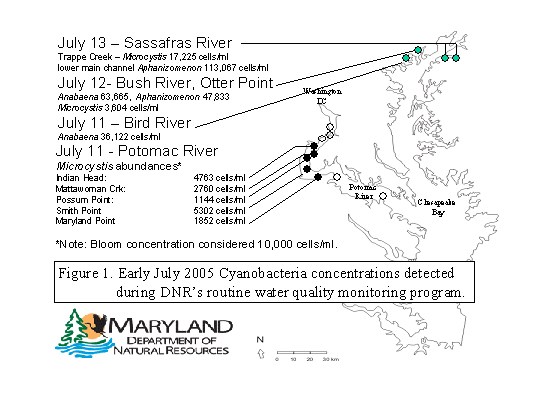On July 13, Maryland Department of Natural Resources (DNR) collected samples from Trappe Creek and the Sassafras River main channel that showed cyanobacteria blooms were present for the first time this year (Figure 1). Aphanizomenon species dominated the lower Sassafras River main channel area at 113,067 cells per milliliter with Anabaena and Microcystis species in lower abundances (19,404 and 9,328 cells per milliliter respectively). Trappe Creek counts were dominated by Microcystis at 17,225 cells per milliliter with low abundances of Aphanizomenon and Aphanocapsa also present (2,650 and 3,180 cells per milliliter respectively).
 |
| Figure 1. 2005 Cyanobacteria Algal Bloom Tracking. |
On July 11, DNR detected Microcystis on the Potomac River for the first time this year over more than 10 miles of water between Maryland Point and Indian Head. Cell concentrations ranged from 1,144 (Possum Point) to 5,302 (Smith Point) (Figure 1), a region where bloom levels are predicted to occur this summer (https://www.chesapeakebay.net/info/news_forecast_spring2005_algal.cfm). Sample levels, however, are still below those considered bloom conditions (> 10,000 cells/ml). The present conditions are producing a visible green color in the water. Surface accumulations of Microcystis in near-shore zones and coves of this region of the river may exceed bloom levels at this time producing thick surface scums as a result of wind-rows and natural current eddies. Evidence of the bloom appears visible on a NASA satellite image from July 10, 2005 (Figure 2) supported by the data collected from July 11.
Initial predictions by scientists regarding bloom predictions on the Potomac River were 1) that a Microcystis bloom would occur this summer, 2) the first Microcystis bloom sample on the Potomac River to be collected during June 3) bloom distribution would be > 10 miles, 4) between Piscataway Creek and Maryland Point and 5) it would last about 2 months. The spring Mahogany tide on Chesapeake Bay was approximately 3 weeks later this year than the similarly widespread bloom of 2000. The delay in the bloom pattern was associated with cool spring conditions that Microcystis bloom timing and development may also be experiencing this year. Additionally, repairs to waste water treatment plants in the watershed that are reducing phosphorus inputs may also be impacting bloom timing, magnitude, distribution and duration. Our knowledge of what causes this bloom is imperfect and additional environmental conditions that we are yet to understand are also likely to change patterns in bloom characteristics.
Bloom conditions for cyanobacteria have been uncommon thus far this year. Water samples collected by a citizen from the Bird River (Baltimore County) and Maryland Department of the Environment this week showed elevated levels of Anabaena between July 7 (visible green water) and 11 (36,122 cells per milliliter). On July 12, a water sample collected from the Bush River at Otter Point on the upper western shore of Chesapeake Bay showed an algal bloom with a mixture of Anabaena planktonica at 63,665 cells per milliliter, Aphanizomenon sp. at 47,833 and Microcystis at 3,604 cells per milliliter. Wide variations in dissolved oxygen and pH are evident in the Continuous Monitoring station data (visit the Otter Point station data through Maryland DNRs Eyes on the Bay website https://eyesonthebay.dnr.maryland.gov/eyesonthebay/index.cfm) indicative of possible algal bloom activity. Bluegreen algae fluoresce outside the range of our present monitoring probes and therefore the chlorophyll levels may not accurately reflect the amount of algae present in the system.
Water quality monitoring will continue throughout the summer tracking the algal blooms and related habitat conditions.
Pockets of blue-green algal blooms may be encountered during boating and other recreational activities. People should take common precautions to reduce the risk of illness or discomfort related to blue-green algal blooms:
- The
public should not swim in areas where a blue-green algae bloom is evident.
- Do not drink water from
any area with the appearance of a blue-green algae bloom.
- If contact is made with problem water,
simply wash off with fresh water.
In some cases, skin irritations may occur after prolonged contact. If
irritations persist, see a physician or local health care provider.
- Keep pets and livestock
away from bloom areas.
Blue-green algal blooms may contain toxins that could be harmful or
fatal to pets and livestock.
- Do
not eat viscera (internal organs) of fish caught in bluegreen bloom
waters.
- Inhalation
exposure to blue-green algal bloom waters may result in irritation of
the eyes, ears, nose and throat with extended recreational activity
on such waterways.
Please note that illness associated with harmful algal blooms is now a reportable illness so physicians should be reporting these to local health departments. The MD DNR in coordination and cooperation with DHMH and MDE will continue to monitor all blue-green algal blooms throughout the state. For up to date information on all of Maryland's harmful algal blooms and water quality, please visit Eyes on the Bay at www.eyesonthebay.net.
|